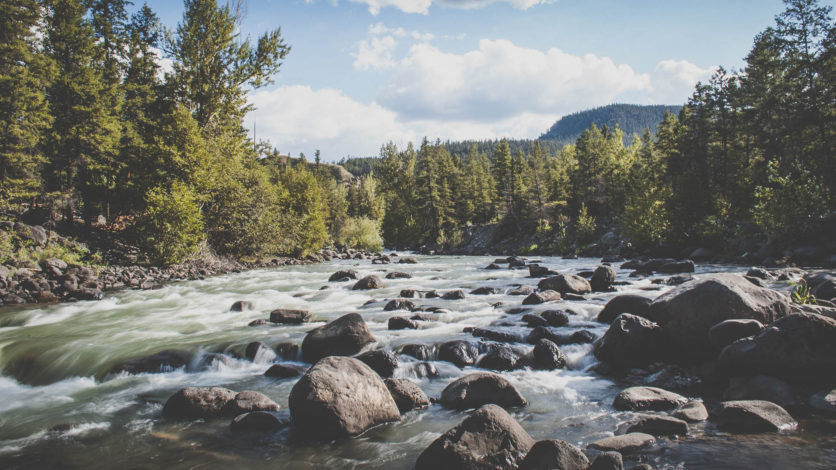Having a safe source of water is one of the most important considerations when planning any wilderness trip. Unfortunately even the cleanest looking water can still contain various potential contaminants.
This guide will give you the essential information on the 5 main water contaminants, how to choose a safe water source and the various water treatment options to make it safe to drink.
Contents
Introduction
• Where to find water when you’re in the wilderness
• How much water do you need?
Choosing a water source
• Streams and rivers
• Lakes and ponds
• Snow
Hygiene
• Hand gel
• Going to toilet
• Cleaning containers
Water contaminants
• Protozoa
• Bacteria
• Viruses
• Parasites
• Chemicals
• Turbidity
Types of water treatment
• Effectiveness of different methods of water treatment
• Boiling
• Chemical treatments
• Water filters
• Ultraviolet-light (UV)
Conclusion
References and further reading
• Books
• Web articles
Introduction
Proper planning can make a big difference to the success of any trip. Knowing how much water you or your group are going to need as well as where you’re going to source water along your route are important considerations before heading off.
How much water do you need?
You’re constantly losing water through urine and sweat which needs to be replenished to stop you dehydrating. That means consuming 2.5 litres a day for a man and 2 litres for a woman.
This can increase quite a lot if you’re undertaking strenuous physical activity such as hiking on a hot summer day. In this case allow for between 4 and 6 litres a day.
You want to avoid dehydration at all costs which means paying attention to the signs. Making sure that you are drinking regularly will prevent dehydration from being a problem.
If you find yourself getting dizzy, passing less urine than normal or very dark coloured urine, developing headaches, feeling tired or if you have a dry mouth, lips or eyes then you need to hydrate yourself as soon as possible.
Obviously you can bring all the water you need for a trip with you. If you’re only going out for a day this is probably the simplest solution and you know for a fact that the water will be safe to drink.
However, if you’re planning a longer journey then it’s not going to be practical to bring the amount of water you or your group are going to need.
1 litre of water weighs 1 kilo (2.2 pounds) so bearing in mind that you’re likely to need at least 2 litres of water a day just for drinking, the weight will soon add up. Of course that doesn’t even take into account the water you will want to use for cooking and camp use.
Where to find water when you’re in the wilderness
The easiest way is to make sure you plan ahead. Check the map of your route ahead of time and identify possible sources of water along the way. Take into account seasonal variations as well.
Some water sources may be dried up in the summer months while during the winter they may be frozen.
Contour lines can give you an indication of where water might be. Streams and rivers tend to form in the valleys so if you are planning to walk along a high ridge you might need to drop down a considerable distance to find water.
Areas with a lot of vegetation will also generally have a good supply of water. Sometimes you may not be able to see a water source but you will be able to hear it. Try keeping quiet for a moment and listen out for the sound of flowing water.
If you’re travelling by canoe or kayak then water shouldn’t be too hard to find given that you’ll be travelling on it all day. That doesn’t mean that all sources are created equal.
If there is evidence of animal activity or outflow pipes then you’ll want to find a different area to source your drinking water. If water is scarce then you may need to hunt for smaller pools or trickles.
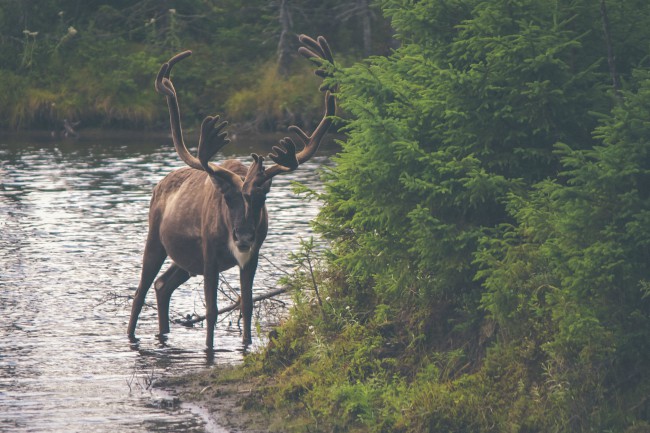
Avoid collecting water from sources with obvious animal activity.
Depending on the area you’re visiting there could be guidebooks that provide information on water sources along your route.
For those hiking popular routes like the Pacific Crest Trail, during the busier months kind volunteers (called trail angels) often set up water caches in the driest areas to reduce the amount of water hikers have to carry.
You could also set up a cache yourself ahead of time if you know there’s going to be no reliable source of water for a long stretch. Just make sure to mark where you placed them and also that they won’t be broken into by animals before you arrive.
Choosing a water source
The obvious difficulty when choosing a water source is that you’re unlikely to be able to tell just be looking at the water what pathogens or chemicals are lurking within it. That said, some sources are going to look far more inviting than others.
[bctt tweet=”It’s impossible to tell how clean a water source is just by looking at it”]Streams and rivers
Fast flowing streams and rivers are generally the safest place to look for water as long as they aren’t flowing through any industrial or residential areas.
A clear mountain spring, far away from civilisation is unlikely to hold any harmful chemicals, and is also more likely to be free from pathogens.
The further downstream you go, potentially the more likelihood there is of encountering something nasty within the water supply.
Look out for evidence of any human or animal activity especially any agricultural or industrial areas nearby. Forestry and mining in the area can also be a potential source of pollutants entering the water source.
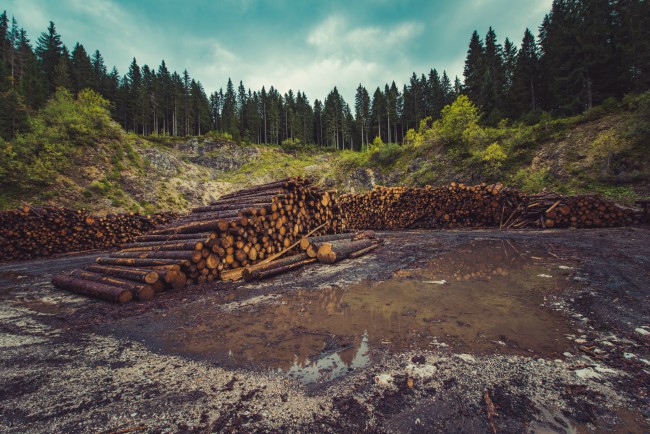
Signs of commercial activities could mean that any water sources in the area have been contaminated.
Check your immediate area as well. Walk a little upstream to see if an animal has died next to the stream or river as this could be potentially very harmful if you collect water downstream of it.
Lakes and ponds
If there aren’t any moving water sources then you may need to source water from a lake, pond or pool. A quick visual check of the water can give you an indication of its quality.
If it’s murky and cloudy, or covered in algae then chances are there’s some kind of pathogen in the water. If it’s sparkling and clear then it’s likely to be safer to drink from but there’s still no way of telling if it’s completely clean.
There is still some debate as to whether to collect water from near the surface or deeper down. There have been statements to suggest that water on the surface is more likely to harbour pathogens but others to suggest that UV light from the sun has a purifying effect on the top layer. There is also information to suggest that Giardia and Cryptosporidium sink in water.
If you are in any doubt as to the cleanliness of the water it’s far better to take precautions than take a risk that could spoil your trip.
Snow
Although it looks white and fluffy, snow can harbour a great deal of bacteria. You’ll definitely want to melt it before consuming it which will mean boiling. This will remove all bacteria from it anyway.
Just make sure to add some clean water to your container before melting any large quantities of snow in it. If you don’t it’s likely to burn the bottom of the pan.
Hygiene
Ensuring that you maintain high standards of hygiene will greatly minimise the risk of contracting a waterborne disease.
That goes not just for keeping yourself clean but also making sure any containers, water filters or treatment systems are carefully cleaned and maintained as well.
Here are some simple practices that you can use to avoid contaminating your drinking water source:
Hand gel
Make sure that you always carry some hand sanitizer with you. They are cheap and you can find them in small, handy containers which can be kept on you at all times.
I always carry many of these on an extended trip. Keep them in places where you’re likely to need them, that way you’ll also be reminded to use them.
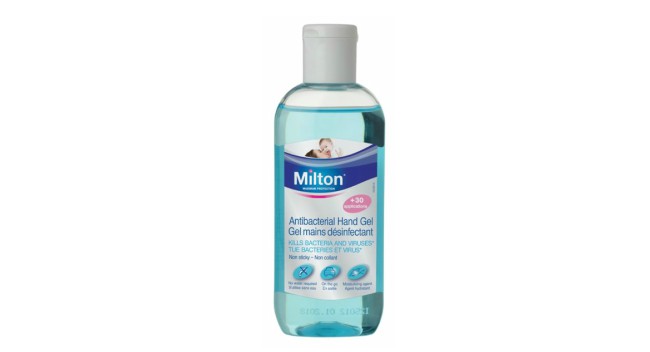
Pocket-sized antibacterial hand gel bottles are cheap and worth having a few with you to keep your hands clean.
I carry one in a pocket and one in my first aid kit as well as with my water filter, cooking equipment and in my toilet pack.
That ensures I always have the opportunity to disinfect my hands to avoid any contamination especially after going to the toilet or after touching untreated water.
Going to toilet
Always go to toilet at least 100m from any water source. That goes for washing yourself or your pots and pans as well.
Liquid cleaners and soap contain chemicals that will pollute the water. Not only is this harmful for the environment but will also contaminate your water supply.
Cleaning containers
It can be difficult to make that all your food and drink containers as well as any water treatment systems are kept clean, especially out in the wilderness.
It could be argued that it’s even more important in these circumstance as you could be a long way from medical attention if you ingest a nasty bug. As well as washing them thoroughly after use I try to sterilise my cooking pots every few days by boiling some water in them.
Also don’t share mugs, bowls or utensils with someone else as you increase the risk of contamination.
And be careful when handling water filters not to dangle any part of them on the ground as you could contaminate it, defeating the object of filtering the water in the first place.
Water contaminants
It’s important to understand exactly what contaminants you’re likely to face in order to be able to deal with them effectively.
It can be very confusing when reading the marketing literature of all the various water filters and gadgets available, each telling you that it’s the best thing since sliced bread.
The information below is not intended to scare but inform. The chances of contracting some of these diseases is very rare other than in specific locations whereas others are more common around the world.
Armed with this information you should be able to make a decision about what you are likely to encounter when planning a trip in different wilderness areas.
Protozoa
Protozoa are single-celled, microorganisms that get food from their surrounding environment. Most are completely harmless but there are many including those in the list below which do causes disease in humans.
- Cryptosporidium parvum
- Giardia lamblia
- Entamoeba Histolytica
- Isospora Belli
- Cyclospora
- Cayetanensis
- Balantidium Coli
- Blastocystis Hominis
- Acanthamoeba
These protozoa form cysts around themselves which acts as a protective wall. Once they enter into any warm blooded animal (such as you or I), the cyst let’s go and lives in the blood stream. These cysts are usually around 2 to 50 microns in diameter, a micron being one thousandth of a millimetre.
The two most common which you should be aware of during wilderness travel are Cryptosporidium parvum and Giardia lamblia. They are generally transmitted into water sources through the faeces of an infected animal or human.
[bctt tweet=”The two most common protozoa are Cryptosporidium parvum and Giardia lamblia”]Symptoms usually develop within one to two weeks which can often include diarrhoea, fever, weight loss, nausea and vomiting.
On contracting either of these diseases, you will often recover within a couple of weeks without any medical intervention but it could easily cut a trip short or at least make it quite uncomfortable for a while.
Bacteria
Bacteria are tiny microorganisms, usually between 0.1 and 10 microns long. They are single-cell organisms that are generally found in large groups of millions.
Bacteria are distributed widely through soil, water, plants, animals and organic material. While many bacteria have positive effects, there are a number of bacterial diseases listed below that you should be aware of.
- Escherichia Coli (E.Coli)
- Shigella
- Salmonella
- Campylobacter
- Aeromonas
- Yersinia Enterocolitica
- Vibrio Cholerae
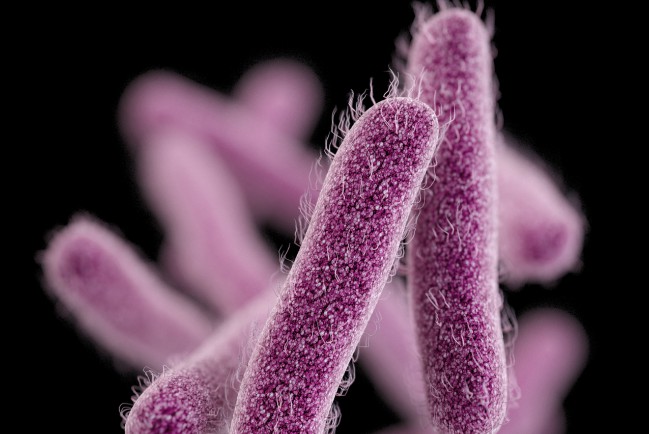
Medical Illustration of Shigella. Source: cdc.gov.
The effects of these diseases vary but commonly you can expect to endure diarrhea, intestinal pain and fever.
Cholera can be deadly but fortunately is very uncommon in the developed world.
If you are planning a trip to a less developed region where there is poorer sanitation then make sure that you have the necessary vaccinations.
Viruses
Viruses are not cells but do require host cells that they infect in order to reproduce. When outside of a cell they are inert but when they come into contact with a cell they are able to take over the host’s functions. Basically a hijacking.
They cause a wide variety of diseases, some of which are listed below.
- Hepatitis A
- Hepatitis E
- Norovirus
- Poliovirus
Symptoms from viral diseases are diverse. Hepatitis A for example, attacks the liver and can include flu-like symptoms, though many people show no signs at all.
Norovirus on the other hand can be very unpleasant for at least a few days causing acute sickness, diarrhea and vomiting.
Viruses are incredibly small (0.004 to 0.1 micron in diameter) which makes them the most challenging to remove from an infected water source.
[bctt tweet=”Viruses are very small making them extremely hard to remove from an infected water source.”]They usually enter the water as a result of animal faeces so choosing sources away from animal activity is very important.
Parasites
A parasite is an organism that lives inside another organism, usually at the expense of the host. It needs to live within another organism in order to survive and gain strength while having the opposite effect on those it occupies.
Though parasites rarely kill (as it isn’t in their best interests) they can cause many health issues.
Here are some examples of parasites that you’d probably like to avoid.
- Ascaris lumbricoides
- Ancylostoma duodenale (hookworm)
- Taenia spp. (tapeworm)
- Fasciola hepatica (sheep liver fluke)
- Dracunculus medinensis
- Strongyloides stercoralis (pinworm)
- Trichuris trichiura (whipworm)
- Clonorchis sinensis (Oriental liver fluke)
- Paragonimus westermani (lung fluke)
- Diphyllobothrium latum (fish tapeworm)
- Echinococcus granulosus (hydatid disease)
Symptoms can include fever, itching, weight loss, diarrhea, fever, nausea and much more depending on which parasite you have become infected with.
They spread easily from person to person especially if you aren’t careful to ensure high standards of hygiene.
Chemicals
Chemical pollutants can come from nearby agricultural, industrial or domestic waste products leaked into the water source. You want to be particularly aware of any mining, forestry or agricultural activities along your planned route if you are collecting water as you go.
Unfortunately as wilderness areas are impacted as a result of commercial activity, chemical pollutants become more common. The effects of ingesting any chemicals within a water supply depends on what the pollutant was and how much you consumed.
Unless there has been a significant amount of chemical waste contaminating a water source the likelihood is that you’ll suffer no noticeable effects from ingesting a small amount, but regular exposure can cause various long term health issues.
Turbidity
Turbidity is the clarity of the water. If you fill a container with a sample of water and hold it up to the light, the more opaque (cloudy) the appearance, the more turbid it is.
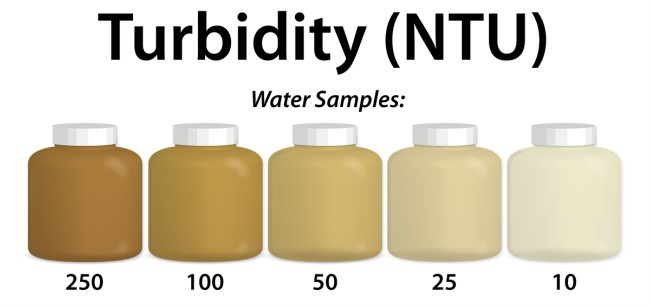
The cloudiness of water is called turbidity which is measured in NTU (Nephelometric Turbidity Units) and is a key indicator of water quality. Source: learnnc.org
The material which causes turbidity include silt, clay, soil, organic matter, algae, plankton and other microorganisms.
After a recent storm when there has been significant rainfall, often river and lake beds are stirred up causing increased turbidity.
[bctt tweet=”Turbid (cloudy) water is a key indicator of water quality.”]If the water is obviously cloudy when you collect it, letting it rest for a while can allow any material in the water to slowly sink to the bottom. You can then use the clearer water near the top.
You want to collect water that is as clear as possible. Not only will particulates in the water increase the chances of clogging any filtration equipment that you’re using but it also increases the likelihood of having collected a waterborne pathogen.
Types of water treatment
Armed with the facts about the types of risks that come with drinking untreated water, what are your options for treating water in the wilderness?
Some people are happy to drink water in certain areas without using any kind of treatment having suffered no ill side effects as a result of doing so for years. Bear in mind that they may have developed an immunity and what might be safe for them to drink, may leave you with a stomach bug.
It’s entirely up to you what risks you do or don’t take when it comes to treating water or not. This article is designed to give you the information to make your own decision.
If you are prepared in advance then you shouldn’t have to resort to survival techniques such as constructing a solar still or collecting rainwater. We’re going to look at some more conventional methods of water treatment that will make your life in the backcountry much simpler and safer.
With all of these treatment methods it’s important to understand their advantages and shortcomings as well as having a backup solution in case your primary method fails.
You also need to consider how many of you are going on the trip and the amount of water that you’re going to need on a daily basis.
Some water treatment methods are more suited for large groups around camp while others are lighter and more portable for solo use.
There’s also the consideration of where you are travelling. Some of the pathogens listed above are prevalent only in certain areas so bear in mind what you are likely to need to filter out when choosing a water treatment.
Effectiveness of different methods of water treatment
Before going into the various methods of water treatment, here’s a quick reference table.
| Method | Contaminant Effectiveness | Advantages | Disadvantages |
| Boiling | Protozoa* Bacteria Viruses Parasites Chemicals Turbidity |
Kills all pathogens. | Can give water a flat taste.
Uses a lot of fuel. Doesn’t remove chemicals. |
| Iodine | Protozoa* Bacteria Viruses Parasites Chemicals Turbidity |
Inexpensive
Can treat large or small volumes. |
Negatively affects the taste.
Doesn’t kill Cryptosporidium. Cannot purchase in tablet form in Europe. Less effective at cold temperatures. Water clarity can affect results. |
| Chlorine dioxide | Protozoa Bacteria Viruses Parasites Chemicals Turbidity |
Inexpensive
Can treat large or small volumes. Leaves no unpleasant taste. |
Less effective at cold temperatures.
Water clarity can affect results. Volatile when exposed to sunlight or air. |
| Filters | Protozoa Bacteria Viruses** Parasites Chemicals*** Turbidity |
Choice of filter types (bottle feed, gravity and pump).
Purification systems effective at removing virtually all contaminants. Leaves no unpleasant taste and often improves it. Range of prices Removes sediment from cloudy water. |
Not all remove viruses.
Most bulky solution. Requires maintenance in the field including backflushing. Could break (especially pump filters). Bottle feed filters are slow and poor for large volumes of water. Gravity filters require somewhere to suspend them from. |
| Ultraviolet | Protozoa Bacteria Viruses Parasites Chemicals Turbidity |
Very fast method of treatment.
Leaves no unpleasant taste. Effective against all pathogens including viruses. Small and light |
Requires supply of batteries.
Could get damaged in the field. Fairly expensive Doesn’t remove any particulate in the water. |
* Not Cryptosporidium.
** Bottle filters such as the Water-to-Go and Lifesaver systems can filter out viruses.
*** Some purification systems can.
Boiling
Boiling water is one of the simplest methods and can be used anywhere provided you are able to light a fire (or have a stove handy) and have some kind of container for boiling the water in.
The two biggest drawbacks are the amount of fuel required especially if you are relying on your stove system and the fact that if you want a cold drink it could take a long time for the water to cool.
The other issue with boiling is that it leaves the water rather flat tasting, though this can be resolved by shaking the water up to aerate it or pour it from one container to another a few times.
Boiling is very effective at killing all pathogens. In fact, even heating water up to between 600C (1400F) and 700C (1580F) for up to 30 minutes will be enough to kill any waterborne pathogens. That’s well below boiling point.
[bctt tweet=”Boiling water is very effective at killing all waterborne pathogens.”]The practical difficulty is knowing the actual temperature of the water which requires a thermometer. Boiling point is easily recognisable and bringing water to the boil kills all organisms within seconds rather than minutes. Allowing a safety margin by boiling water for one minute will ensure that everything is killed.
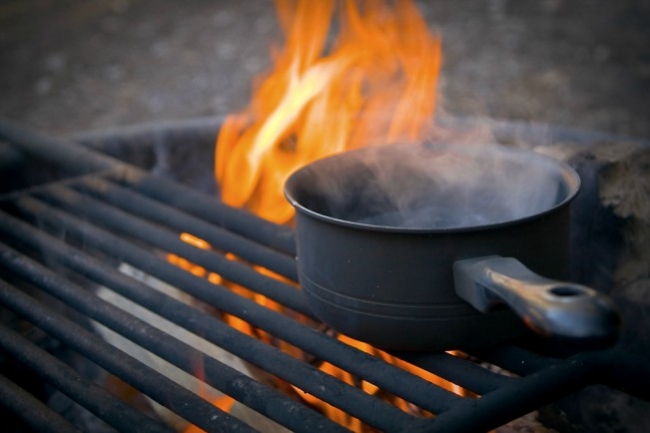
Boiling water is effective at killing all pathogens but requires a lot of fuel. Source: Flickr
If you want to conserve fuel then bringing the water to the boil and allowing it to sit in a covered container for a few minutes will have the same effect.
When increasing in altitude, the boiling point decreases meaning that it needs to be boiled for longer. Allow water to boil for 3 minutes when above 2000m (6562 feet).
| Altitude (feet) | Altitude (metres) | Boiling Point |
| 5,000 | 1,524 | 950C (2030C) |
| 10,000 | 3,048 | 900C (1940C) |
| 14,000 | 4,267 | 860C (186.80C) |
| 19,000 | 5,791 | 810C (177.80C) |
Boiling temperatures at different altitudes.
It’s also worth noting that boiling water does not remove any chemical pollutants, only organic organisms.
Chemical treatments
Chemical treatments can be an effective and lightweight solution to disinfecting water. Their effectiveness is impacted by concentration, contact time, turbidity and pH.
They are also less effective at lower water temperatures. For any chemical treatment it’s wise to double the amount of time they are left before drinking at temperatures below 40C (400F).
You could warm the water first by resting the container in the sun for a while before adding the chemical treatment.
Iodine and Chlorine
Both Iodine and Chlorine have been used extensively in the past for treating water. Both leave a pretty unpleasant taste in the mouth and neither are effective at removing Cryptosporidium.
[bctt tweet=”Neither Iodine or Chlorine are effective at removing Cryptosporidium.”]The European Union effectively stopped the sale of Iodine tablets as a water treatment method in 2009. It’s still possible to buy Iodine but you need to be careful to dilute it correctly. You can still buy the tablets in North America, just none of the EU member states.
The poor taste can be improved by purchasing taste neutralizing tablets or adding a powdered drink flavouring of your choice.
If you have thyroid problems, are pregnant or are taking lithium tablets then make sure to consult your doctor before using Iodine.
Chlorine dioxide
Chlorine dioxide tablets are more effective than either Iodine or Chlorine and are able to kill off all microorganisms including Cryptosporidium. It works by releasing highly activated oxygen into the water in order to kill off organisms.
[bctt tweet=”Chlorine dioxide tablets can kill off all microorganisms including Cryptosporidium.”]To remove Giardia they need to be left in the water for 30 minutes and removing Cryptosporidium takes 4 hours. That will give you some idea how tough Cryptosporidium is.
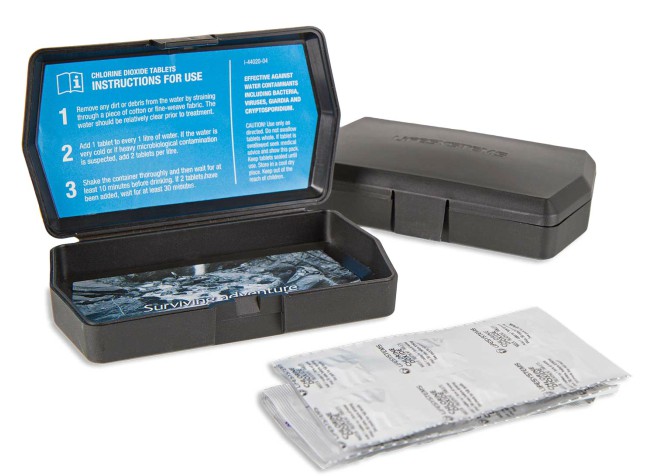
Chlorine dioxide tablets are cheap and very effective at killing all pathogenic organisms including Cryptosporidium.
The other advantage of Chlorine dioxide is it has very little effect on the taste of the water. In fact it’s used in most general water supplies so the taste will probably be very familiar.
Much like Iodine, Chlorine dioxide is effective at removing viruses as well as bacteria and protozoa.
Water filters
Using a form of filter is usually one of the preferred methods of dealing with water treatment in the wilderness.
The way a filter works is as a strainer. Water is forced through tiny holes in the filter which are too small to let microorganisms through.
Most filters don’t kill viruses so if you need to deal with viruses as well you’ll need to purify the water instead. A purifier is usually a combination of a filter and a chemical or UV treatment. If you brought Chlorine dioxide tablets and a filter you would be able to remove viruses as well as protozoa and bacteria.
[bctt tweet=”Most backcountry water filters don’t kill viruses but purifiers do.”] One of the advantages to using any filter is it can often improve the taste of the water.Type of water filter
Water filters come in three basic designs in the way that they work. Each have their own advantages and disadvantages depending on your needs.
Bottle feed / squeeze filters
A bottle feed or squeeze filter substitutes for the lid of the bottle. As a result they are lightweight and easy to use, with no moving parts to go wrong or maintain. That makes them very popular with backpackers and thru-hikers.
I often use a Sawyer Squeeze filter when travelling alone as it allows me to treat water very quickly when on the move. It’s also inexpensive and is likely to last an extremely long time before needing replacing.
They usually come with some type of syringe for backflushing the filter though it’s not always effective.
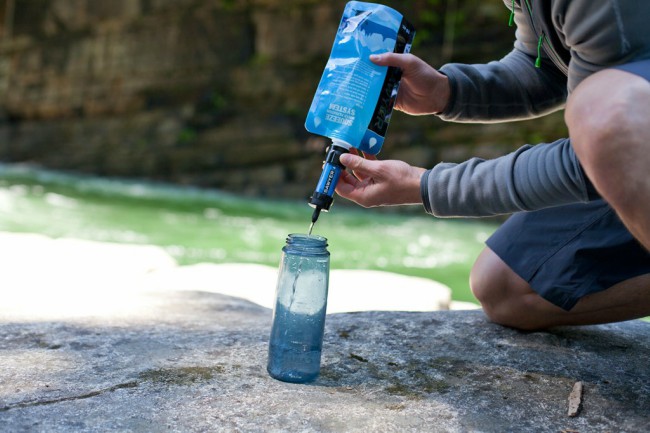
Squeeze filters like the Sawyer Squeeze are highly portable and great for solo use.
Two slightly more unique options are the Water-to-Go and Lifesaver Systems bottles. These are standalone bottle containers that have a built-in filter included in the lid. These filters do remove viruses and are used and tested in humanitarian aid areas.
I do own a Water-to-Go bottle but I find in practice its use is quite limited due to its lack of versatility.
The general downsides to using any of these types of filter is that they require some time and effort to squeeze the water out which makes them less than ideal for use in a group.
They’re best suited to collecting drinking water rather than for use in cooking or camp as you’re going to spend a long time squeezing water into another container.
Gravity filter
A gravity filter (also known as an inline filter) works by suspending a bag full of untreated water up in the air and allowing that water to run down through a filter before being collected in a container below.
It’s great for use in groups as it can treat a large quantity of water relatively quickly. This is the method I use on any trip when I’m with others.
Because the water bags lie flat when empty this system doesn’t take up much room in your pack and is much easier to use on larger amounts of water than a bottle feed system.
Unlike a pump system there aren’t any moving parts so there’s not a lot to go wrong. It’s also easily field maintainable and backflushing is achieved by inverting the system and allowing filtered water to clean out any sediment stuck in the filter.
The gravity filter I use is the MSR Autoflow which allows me to treat up to 4 litres at a time. Once it’s suspended (usually from a tree), you can go off to do other things around camp while your water is being filtered.
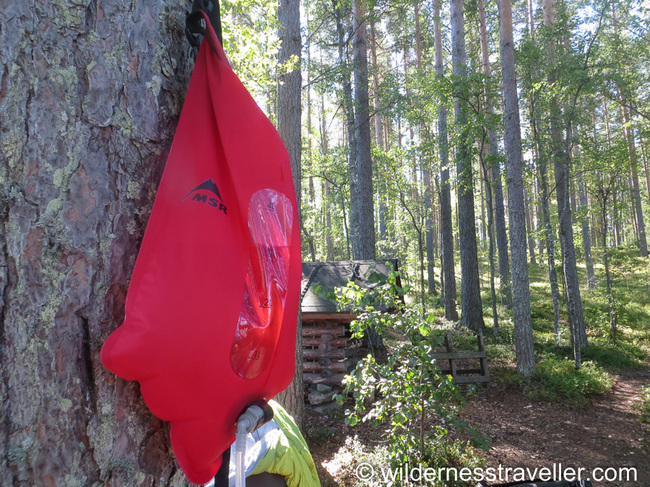
Gravity filters are best used for two or more people and where there are trees to to suspend it from.
There are some downsides to using a gravity filter. If you are travelling through an area with no trees it’s going to be difficult to suspend it without holding it up in the air.
I’ve been forced to do this in the past and can’t recommend it. Water is very heavy and it negates the advantage of being able to do other things while the water is being filtered.
The other disadvantage is trying to use this filter in small or harder to reach water sources. It’s best suited to deep or fast flowing water where you can get the water collection bag completely submerged.
For canoeing I find this filter ideal as if there’s enough water to float the canoe, there’s enough to be able to use this filter easily.
Pump filter
Pump filters are similar to gravity filters in terms of the speed of treating water and their weight. They work by trailing a hose into the water source which you then pump through a filter and collect in another container.
The advantage to using a pump filter over a gravity filter is its ability to reach water from smaller and shallower sources. You also don’t need to find anywhere to hang them up which could be useful above the treeline.
MSR have recently released a new purifying pump filter called the Guardian. It has a unique self-cleaning system so you don’t need to worry about backflushing as you do with other types of filters. It also states that it can effectively remove viruses as well. It’s very expensive though.
The downside to using pump filters is the amount that can go wrong with them. While well made pump filters are pretty reliable and durable I’m always concerned about taking anything into the wilderness that has moving parts which can fail.

Pump water filters are good for group use and allow access to small water sources. Be aware of the potential for anything with moving parts to fail.
Some people love pump filters and prefer them over the other types of filters and it might suit you depending on your likely water sources. Again they are good for group use and as with all filters they are best used with water that has low turbidity.
Ultraviolet light (UV)
UV treatment is still relatively new compared to filtration or chemical treatment though it is very effective at neutralising bacteria, protozoa and viruses.
[bctt tweet=”UV water treatment is very effective at neutralising bacteria, protozoa and viruses.”]They work by focusing ultraviolet into the water which attacks the DNA of any microorganisms within it. It’s a very neat method that also doesn’t affect the taste of the water in any way.
Ultraviolet systems such as the SteriPEN don’t filter any debris out of the water so if the water is murky then it’s best to strain it through a cloth or bandana first before using the UV light.
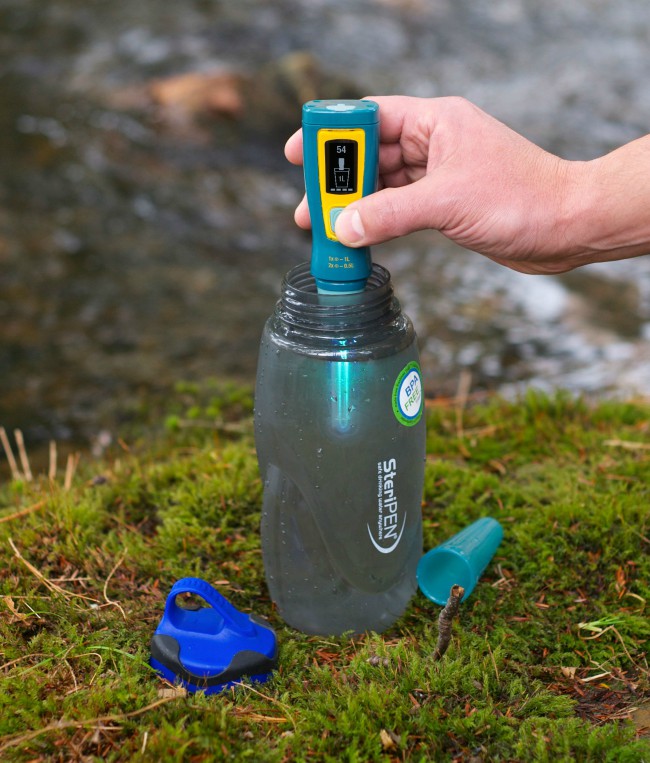
Using a portable ultraviolet light is effective at neutralizing most pathogens including viruses. They are small but not cheap and are reliant on batteries to work.
The main drawback to using a UV treatment other than they can usually only treat small quantities of water at a time, is their durability.
In much the same way as the pump system, to my mind there’s a risk to taking a water treatment method that can be easily damaged or could simply run out of battery power during the trip.
That said it’s very lightweight and effective as long as you’re careful with it and make sure you have enough spare batteries for the duration of your trip.
Conclusion
Hopefully that has given you a clear overview of how to source and treat water safely while out in the wilderness as well as awareness of the typical contaminants that can be found in water sources around the world.
How do you treat water when on a wilderness journey?
It would be great to hear any experiences or difficulties you’ve had when sourcing or treating water in the comments section below.
References and further reading
Books
Expedition and Wilderness Medicine – G. H Bledsoe, M.J Manyak and D.A Townes, Cambridge University Press, 2009.
Field Guide to Wilderness Medicine, 4th Edition – P.S Auerbach, B.B Constance, L. Freer, Elsevier, 2013.
Wilderness First Aid, Emergency Care in Remote Locations, 4th Edition -H.D Backer, W.D Bowman, B.C Paton, P. Steele, A.L Thygerson, S. M Thygerson, B. Gulli, Jones & Bartlett Learning, 2014.
The Comprehensive Guide to Wilderness First Aid – Clifton C. Castleman, Lulu Enterprises, 2011.
The Backpackers Handbook, 4th Edition – Chris Townsend, McGraw Hill, 2011.
Web articles
- Drinking Water for Hiking: Myths and Facts
- The Rules for Backcountry Water Drinking
- How to Find and Purify Drinking Water in the Wilderness
- How Long To Boil Drinking Water?
- Princeton University Guide To Water Purification
- Oxford Journals: Water Disinfection for International and Wilderness Travellers
- Water Purification: The 5 Contaminants You Need to Know About
- Backcountry Water: What Are The Risks?
- Water Treatment: How To Choose a Water Filter
- A Guide To Drinking Water Treatment and Sanitation For Backcountry & Travel Use
- How to Select a Backpacking Water Filter and Treatment System
Share this Post

